News
BNI, Coal, News, Blog
Wednesday, August 10, 2022 4:05 PM
BNI Coal, a subsidiary of ALLETE Inc. on Monday, Aug. 8 commissioned Legacy, a new 11-million-pound dragline at its Center Mine that will keep the lignite mine operating efficiently for years to come.
More than 100 people gathered for the event on the yard where Legacy is being assembled and painted. The commissioning was the culmination of a large project that began in April 2021 with the purchase of the dragline from Mississippi Power Co. Legacy arrived at the Center Mine as individual components that were disassembled into sizes small enough to be trucked from Mississippi to North Dakota. They were then reassembled onsite over the course of more than a year.
BNI contracted with Specialized Construction Services to disassemble and reassemble the dragline, which is nearly complete. The $31 million project will replace an older dragline, Big Jake, that is being retired, and was more cost-effective than rebuilding the older dragline.
“The commissioning of Legacy builds on BNI’s nearly 100-year history in North Dakota as a large employer with a commitment to environmental stewardship,” said BNI General Manager Mike Heger. “What you see here is a $31 million capital investment in the future of North Dakota’s lignite industry and our dedication to providing a reliable and affordable energy resource.”
Legacy joins Liberty, a similarly sized dragline that was put into service in 2004. (To see Liberty in action from the operator’s cab, watch the video below.) The pair of draglines are the primary earth-movers at the mine, which reliably and affordably supplies lignite to Minnkota Power Cooperative’s nearby Milton R. Young Generating Station.
ALLETE Vice President and Corporate Treasurer Pat Cutshall said Legacy’s purchase and commissioning are important milestones for BNI Coal.
Cutshall said the 214 truck delivery trips necessary to move Legacy from Mississippi to North Dakota could have circled the globe 12 times, the entire project will take about 120,000 hours of work to complete, and Legacy’s bucket can hold 7,000 basketballs or about 32 million gummy bears.
He also said Legacy, which will operate on electricity taken directly from the local grid, is one of the world’s largest electric vehicles.
“This will sustain and enhance not only jobs, but also the local, regional and North Dakota economies,” Cutshall said, and praised the BNI team that is bringing the dragline project to a successful conclusion. “You should all be proud of yourselves.”
Also speaking at the event were Randy Christmann, North Dakota Public Service Commissioner; U.S. Rep. Kelly Armstrong; and U.S. Sen. Kevin Cramer. Cramer praised BNI’s land reclamation excellence, saying the prairie draws and woodsy areas BNI leaves behind are even more spectacular than the originals.
Heger then introduced third-generation BNI employee Kim Peterson, who submitted the name Legacy during BNI’s naming contest, to break a bottle of champagne against Legacy’s bucket, keeping a tradition that started with BNI’s first dragline. Peterson’s grandfather worked for BNI’s predecessor company, Baukol-Noonan, at the Noonan Mine in Divide County, North Dakota, before the company moved operations to the Center Mine in Oliver County in 1970. Minnesota Power purchased Baukol-Noonan in 1988 and changed the company name to BNI Coal.
“I just thought of my family history with the mine, and the history of coal mining in the state, and Legacy just seemed to fit for me,” Peterson said of coming up with the name.
Heger said Legacy, a 757 Page dragline, will be operational in about six weeks and replace 45-year-old Big Jake, also a 757 Page model.
Some more fun facts about the new dragline:
- The boom is 310 feet long, with an operating radius of about 286 feet, so it can move dirt about 572 feet from one side to the other.
- It has a rated suspended load of 375,000 pounds.
- The tub on the bottom is about 65 feet in diameter.
- The house is about 105 feet long and about 80 feet wide.
- Legacy stands 286 feet tall, about 44 feet taller than North Dakota’s state Capitol.
Thursday, June 10, 2021 8:39 PM
|
Mike Heger, BNI general manager
|
| |
Mike Heger, a 14-year veteran of BNI, has been named the company’s general manager. Heger’s promotion comes as Wade Boeshans, BNI president and general manager, departs ALLETE to pursue a new opportunity.
“Mike is passionate about positioning the mine to continue operating successfully for many years to come. His experience, operational and analytical abilities, and commitment to a strong safety culture will serve him well in his new leadership role,” said Pat Cutshall, ALLETE vice president and corporate treasurer who has broad oversight of BNI. “With Mike’s leadership, BNI will continue its support of carbon-capture technology to help secure a cleaner energy future while remaining committed to the North Dakota lignite industry.”
Heger joined BNI in 2008 and has held the positions of senior mine engineer, engineering manager and production manager. He was named director of operations in 2019.
“I’m optimistic about BNI’s future and look forward to the challenges and opportunities ahead,” Heger said. “I’m proud to be a part of this team and contributing to BNI’s track record of safe, responsible and environmentally sound mining.”
Boeshans has taken a position with Iowa-based Summit Carbon Solutions which focuses on carbon capture and storage for biorefineries. He will remain at BNI until early July to ensure a smooth transition.
Bethany Owen, ALLETE chair, president and CEO, said Boeshans has been a tremendous leader and a strong safety advocate for BNI and ALLETE.
“One of Wade’s many strengths is his ability to forge relationships founded on integrity, respect, and credibility, which have been so important as BNI has navigated the ever-evolving external world,” Owen said. “I am grateful to Wade for his leadership and friendship over the years and for his development of the strong and experienced team at BNI. I am confident that with Mike’s leadership, the entire BNI team will continue this momentum for a more sustainable future for ALLETE and the state of North Dakota.”
Boeshans said the urgency to find energy solutions that balance environmental concerns and energy needs of consumers is increasing.
“North Dakota is uniquely situated to meet the demand for environmentally and economically sustainable energy, and BNI has been a leader in advancing carbon solutions for a decade,” Boeshans said. “I am humbled and honored to have led BNI for the past 12 years and proud of how we have positioned the company for success with a talented team that lives our values every day, the progress of the Project Tundra carbon solution, and a recapitalized mining operation with over 100 million tons of coal under permit. I couldn’t be prouder of the team or more confident in the future of the company. The work BNI is doing complements what other companies are doing to advance carbon solutions, and I’m excited to work on carbon capture from another perspective to benefit North Dakota and the region.”
BNI’s Center Mine, located near Center, North Dakota, celebrated 50 years of mining in November 2020 and delivers between 4 and 4.5 million tons of lignite to Minnkota’s Young Station each year. BNI is working with partners such as Minnkota and the state of North Dakota to advance clean carbon solutions, including carbon sequestration technology, that are critical to the coal industry and could help solve climate issues.
Friday, February 14, 2020 10:31 PM
Minnkota and BNI Coal build stronger relationship around optimizing plant and mine practices
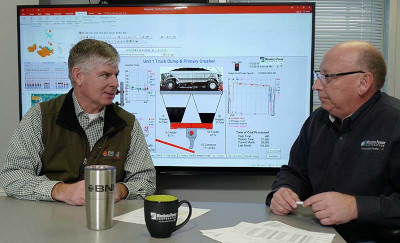
BNI Energy President and General Manager Wade Boeshans (left) and Minnkota Senior Manager of Power Production Craig Bleth discuss their collaborative team’s next steps toward efficiency and savings. (Minnkota/Kevin Jeffrey)
The ease with which Wade Boeshans and Craig Bleth teasingly recount a missed breakfast meeting makes them sound like boyhood friends – not the ones leading the show at BNI Energy and Minnkota’s Milton R. Young Station.
Boeshans and Bleth, president and general manager of BNI Energy and Minnkota senior manager of power production, respectively, have grown close over the past few years. The bond is a part of the companies’ recent joint initiative to build a stronger partnership for streamlining processes, eliminating redundancies and achieving lower total costs for the joint enterprise.
BNI Coal and Minnkota have been solid power partners for 50 years. But in a 2016 discussion between Boeshans and Minnkota CEO Mac McLennan, the leaders recognized they were entering an era of new challenges facing their facilities, their operations and the industry.
“BNI and its mining operation and this plant are ultimately co-destined,” Boeshans said. “Our futures are tied together. There is no ‘one wins, one loses.’”
The companies joined each other at the table and began to develop a cosponsored mine optimization plan, taking ideas from every level of the organizations.
“We were looking at ways to increase efficiencies, focused on saving money,” Bleth said of those early planning days. “We acknowledged that BNI has certain strengths that we could utilize, like their work with heavy equipment.”
“The response from the team was phenomenal, in terms of the openness of thinking and the types of opportunities that were brainstormed,” Boeshans said. “Over three to six months, we identified a set of initiatives that we were able to work together on to integrate into our respective operations.
“We realized, boy, we can do great things together,” he added. “It evolved in that way.”
Coal delivery examination
The details of the plan took hold in 2018. The companies laid out their optimization agenda – modifying the coal delivery and plant feed process; reclaiming and expanding the coal stockpiles; and finding ways to share equipment, services and knowledge.
One of the first projects was coal delivery. “That ultimately was the lowest-hanging fruit that wasn’t identified by me or Mac or Craig, quite frankly,” Boeshans said. “It was the guys who were in the trenches and managing this day-to-day.”
The idea came from BNI’s newly promoted production manager, Mike Heger, who realized that if weekly coal deliveries to the Unit 1 and Unit 2 generators were sequenced differently, efficiency would improve significantly.
“He modeled it all out, brought it to this optimization team and presented it there. We looked at it and said, ‘That’s really cool,’” Boeshans recalled.
The changes have allowed BNI to move from delivering 250-280 tons of coal per truck hour to 320 tons, creating a potential annual cost reduction of $1-2 million.
Active stockpile expansion
The team uncovered another money-saving collaboration long-buried in the mine – a million-ton field stockpile of coal that was established more than three decades ago for insurance against major events (weather, mechanical or labor related) that could interrupt coal deliveries to the plant.
Company leaders felt their proven delivery reliability had eliminated the need for that level of inventory, and that it should be reclaimed and replaced with an expanded, readily available stockpile right next to the plant. The size of the plant’s active coal stockpile increased from 60,000 tons to 250,000 tons.
“The costs for mining the field coal stockpile were incurred long ago. What’s left is the load and haul costs, which results in a cost reduction to us,” Bleth said. Recovering the coal and reclaiming the area also eliminates a future reclamation liability.
The stockpile expansion started in 2018 with permitting, regulatory approval and engineering. Minnkota moved power lines in the spring of 2019 to allow for the expanded active stockpile and major excavation dirt work was completed in September. By the end of October, BNI started to add coal to the new, efficient stockpile.
Overall, Minnkota and BNI estimate the stockpile adjustments will create $3-6 million in cost reductions over the five-year timeframe in which they reclaim the pile.
Shared equipment and expertise
The committee then examined the companies’ resources and determined BNI had heavy equipment maintenance capabilities and expertise that Minnkota could use. While Minnkota has six pieces of heavy equipment, such as haul trucks, bulldozers and loaders, BNI has more than 50. Until this year, Minnkota had been paying an outside company to perform its preventative and breakdown maintenance. Allowing BNI to work the equipment into its maintenance rotation would be achievable and more cost-effective.
“One way or another, we pay for the work. But when we pay BNI for the work, there is a return on the other side, since the mechanics’ time on our equipment is deducted from the cost of coal,” Bleth explained. “It’s almost like getting the work for free. Those are the kinds of things Wade understood for a while, but it took time to get us all to understand,” he added with a laugh.
“It took a while to understand the accounting together,” Boeshans replied with a smile.
The team also recognized some equipment redundancies between the mine site and the plant site.
“We have the exact same front-end loader. We use it less than 10% of available hours, but we need it to run our businesses,” Boeshans said. “So we decided to just share one loader between us. That’s just one example of the ways in which we can share equipment and expertise between our two organizations.”
Minnkota and BNI have also put their brains together to develop better coal-handling and blending processes and share earthworks projects. They will continue to seek other opportunities as the optimization initiative moves forward, using both state-of-the-art data analytics and old-fashioned teamwork to preserve their co-destiny.
“All of this is a part of what we already do. We get together and we figure things out,” Boeshans said. “That was, to me, one of the biggest values of this initiative – the relationships that were built over the common goal of working together.”
Story by: Kaylee Cusack
Photography by: Kevin Jeffrey
Wednesday, May 29, 2019 3:46 PM
One thousand days equals 24,000 hours or 1,440,000 minutes. As of April 10, that’s how long BNI Coal has gone without an on-the-job injury that resulted in an employee missing time from work.
It’s believed to be the first time in BNI’s 90-year history that the company has achieved the 1,000-day milestone, and reflects the hard work and renewed commitment to safety following an accident in November 2013 that resulted in an employee losing a leg.
“This tremendous accomplishment reflects how employees strengthened their commitment to a Zero Injury safety culture,” said Wade Boeshans, president and general manager of BNI Energy. “We came together five years ago on the heels of John’s (Renaud) serious injuries, formed what we called the Safety Culture Team, and recommitted to Zero Injury.”
After Renaud’s accident, all employees participated in a strengths, weaknesses, opportunities and threats analysis regarding safety. That led to the formation of the Safety Culture Team that identified safety initiatives focused on training, hazard recognition, communications and accountability.
“This was a significant inflection point in the safety culture at BNI in which all employees demanded complete commitment, engagement and accountability for safety from themselves, their co-workers and the organization,” Boeshans said. “While I am pleased with the 1,000-day accomplishment as it reflects all the hard work we did, I am most proud of the team for changing the safety culture. Nearly half of BNI employees joined the organization in the last five years and were not part of the safety analysis or the Safety Culture Team, and yet the safety culture has transcended workforce transition. I couldn’t be prouder of our team and our organization for the courage and the commitment to change culture.”
BNI celebrated its achievement on April 11 with breakfast for first shift employees and lunch for second shift workers.
“This milestone is a true testament of our employees continued focus on not ‘just having to be safe’ but ‘wanting to be safe,’ ” said Jay Volk, health, safety and environmental services manager. “It is a huge part of what makes BNI successful.”
Mike Heger, operations manager, agrees.
“One thousand days without an LTA (lost time accident) is a very impressive accomplishment for an operation of our size,” Heger said. “This achievement is the direct result of a tremendously improved safety culture at BNI, coupled with a few modest improvements to our equipment and processes. I see this as a strong signal that our ultimate goal of Zero Injury is attainable and well within reach. Congratulations to the entire organization.”
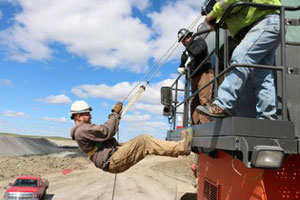
Excavator operator Casey Leingang participates in recent self-descent training at BNI. The training teaches operators how to quickly and safely exit an excavator in case of an emergency that cuts off access to the regular exits.

A Kress coal hauler loaded with 240 tons of lignite from the Center Mine makes its way to the Milton R. Young Station, where it will be used to generate power. Nearly all the lignite coal mined by BNI is consumed at the Young station.
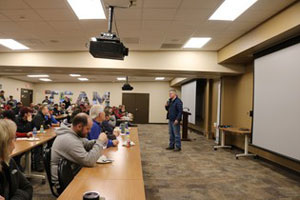
Wade Boeshans, BNI president and general manager, congratulates the BNI team for achieving 1,000 days without an on-the-job injury that resulted in an employee missing time from work. BNI celebrated the achievement with breakfast and lunch for employees.
Wednesday, May 29, 2019 3:31 PM
Donations from ALLETE Clean Energy and BNI Energy will help the University of Mary build a new School of Engineering.
ALLETE Clean Energy and BNI Energy each gave $25,000 toward the new home for the engineering school at the private Catholic university in Bismarck, North Dakota. The University of Mary broke ground April 25 on the $12 million project, an aggressive renovation of the university’s old North Dining Hall. Currently, engineering classes are scattered across the campus.
“BNI and ACE are proud to partner to provide a collective $50,000 donation toward this important workforce development resource,” said ALLETE Clean Energy President Al Rudeck who attended the groundbreaking on behalf of ALLETE.
The university’s engineering program began enrolling students in 2016, when the program was created in response to an increasing demand for engineers, especially in the oil fields of western North Dakota. Today, the university offers civil, mechanical and electrical engineering and expects to have about 120 students enrolled this fall. The program graduated its first student in April.
BNI President and General Manager Wade Boeshans said the donation is a reflection of ALLETE’s commitment to education and the importance of developing a skilled workforce.
“Workforce demands in North Dakota and the region continue to grow, and we’re honored to play a part in helping the University of Mary educate the next generation of engineers, fill a workforce shortage and support a healthy economy,” Boeshans said.
 University of Mary President MonsignorJames Shea and ALLETE Clean Energy President Al Rudeck at the groundbreaking ceremony in April for the university’s engineering school.
University of Mary President MonsignorJames Shea and ALLETE Clean Energy President Al Rudeck at the groundbreaking ceremony in April for the university’s engineering school.
 Wade Boeshans
Wade Boeshans
Tuesday, May 1, 2018 12:00 AM
BNI Energy President and General Manager Wade Boeshans assumed the role of chairman of the Lignite Energy Council at its board meeting on April 4. Boeshans replaced outgoing chairman Paul Sukut, general manager and CEO of Basin Electric, at the LEC’s spring board meeting.
Boeshans shared his family history of growing up in the heart of North Dakota coal country, where his family has lived for generations. He recalled his early childhood as a proud Beulah Miner and what the economic benefits of lignite coal industry expansion in the 1970s and early 1980s meant to the state, the region, his family and the region’s way of life.
“I am honored to be serving as the chairman of the Lignite Energy Council for the next two years,” Boeshans said to the several hundred LEC meeting attendees. “We have a unique opportunity to position the industry for continued success amid a variety of industry trends.”
Also at the meeting, ALLETE Chairman, President and CEO Al Hodnik transitioned ALLETE’s LEC board seat to Al Rudeck, president of ALLETE Clean Energy.
“It has been rewarding for me to contribute to LEC’s strategy and member value proposition” Hodnik said. “ALLETE’s support of the Lignite Energy Council is illustrative of our employees developing strong partnerships in our shared purpose to answer the call to transform the nation’s water and energy landscape. Wade and Al make a great team and will carry sensible energy policy and thought leadership forward, consistent with ALLETE’s all-of-the-above energy policy philosophy and sustainability value.”
ALLETE has been a longtime member of the Lignite Energy Council, a trade association of more than 250 companies that together maintain a viable lignite coal industry and enhance development of the region’s lignite coal resources for use in generating electricity, synthetic natural gas and valuable byproducts. Members of the Lignite Energy Council include mining companies, major consumers of lignite, and businesses that provide goods and services to the lignite industry.
The lignite industry is North Dakota’s fifth-largest industry behind agriculture, oil and gas, tourism and manufacturing. The lignite industry (coal mining and coal conversion) accounted for $3.4 billion of the state's economic base in 2015.
This article was reprinted with permission from ALLETE Stream.


Wade Boeshans Al Rudeck
Monday, January 1, 2018 12:00 AM
A record-setting year at BNI’s Center Mine helped propel total lignite production in North Dakota to a banner year in 2017.
The Center Mine produced more than 4.65 million tons in 2017, topping its previous record of 4.60 million tons in 2002. Together, North Dakota’s five mines produced 29.1 million tons of lignite in 2017, which was the highest annual tonnage since 2009.
Wade Boeshans, president and general manager of BNI Energy, said 2017 was a milestone year for BNI on many fronts: sales, profitability, project execution, safety and environmental performance, and costs to customers that were 7 percent below budget.
“These results are a true reflection of our team’s commitment to the right results, the right way,” Boeshans said. “Our strategy for our mining operations going into the year was to focus on safe, efficient and cost-competitive operations. We knew that we had to effectively execute this strategy while living our values to bend our cost curve and position our customers to compete in a very competitive power market. I’m very proud of our team, their commitment to our values and strategy, and the results they delivered in 2017.”
BNI celebrated its achievement on January 11 with a fleischkuekle feed at the mine and the company also purchased vests for all BNI employees. The Center Mine feeds the adjacent Milton R. Young Station, which recorded its second highest peak for most electricity generated in a single year over the past 40 years. The Minnkota Power Cooperative’s power plant had an extended maintenance outage in 2016 and a number of major outages in recent years as it invested more than $425 million in environmental upgrades, but there were no major outages in 2017.
Here’s what other North Dakota mines produced in 2017, according to the Bismarck (N.D.) Tribune:
- Freedom Mine north of Beulah, the largest lignite mine in the United States, produced and sold more than 14.7 million tons of lignite to the Antelope Valley Station, Leland Olds Station and the Great Plains Synfuels Plant. All three plants are owned by Basin Electric Power Cooperative.
- The Falkirk Mining Co. near Underwood produced 7.2 million tons, which were sold to Great River Energy’s Coal Creek Station and Spiritwood Station.
- The Coyote Creek Mine sold 2.1 million tons to Otter Tail Power Co.’s Coyote Station. North American Coal Corp. owns the Freedom Mine, the Falkirk Mine and the Coyote Creek Mine.
Dakota Westmoreland’s Beulah Mine sold 437,000 tons to Montana-Dakota’s Heskett Station north of Mandan.
North Dakota’s seven lignite-based power plants generate enough electricity to serve 2 million families in North Dakota and surrounding states.
“The lignite industry is unique in that our plants are generally adjacent to the mines, which reduces transportation costs,” Jason Bohrer, president of the Lignite Energy Council, said in a statement. “It also
means our state benefits from the jobs associated from both the mines and the power plants along with low-cost, reliable electricity generated from lignite.”
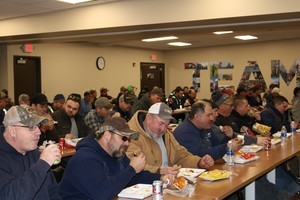
BNI Employee Celebration
Sunday, October 1, 2017 12:00 AM
BNI Coal received the North Dakota Award for Excellence in Surface Coal Mining and Reclamation from the Public Service Commission at the Annual Fall Meeting of the Lignite Energy Council. BNI received the award for “Reclaiming an Inert Waste Disposal Facility at the Center Mine.”
The waste disposal facility was a mining pit that was permitted under mining regulations. It was mined in the late 1990s. After coal removal, BNI removed the acreage from the mining permit. Minnkota Power then permitted the area as a waste disposal facility under the Department of Health. The disposal facility was designed to support 30 years of bottom ash production from the Milton R. Young Station. As new markets for bottom ash developed, Minnkota no longer needed the area for ash disposal.
To reclaim this area, BNI analyzed several different scenarios and determined that redisturbing and reshaping previously reclaimed land around the ash cell was the most cost-effective option. This option required significant permit revisions. These revisions laid out the plan for restriping previously mined areas around the ash cell and cutting out areas of spoil to fill the pit. BNI opened up 86 acres of previously reclaimed land surrounding the ash cell as a borrow area.
Approximately ten feet of spoil material was removed from the area and used to help fill in the pit. The topography of the borrow area was then reshaped to blend the newly reclaimed area into the surrounding reclamation land.
All told, BNI removed 8 stockpiles, most of which were twenty or more years old. 2.9 million cubic yards of spoil were required to fill the cell, which required BNI to move over 1 million cubic yards of soil a year beginning in 2015. After initial seeding, which will be done in the spring of 2018, BNI will be able to initiate the 10 year liability period on almost two sections of land that was being used for the ash cell, stockpiles, diversions, and roads. This land will then be eligible for final bond release.
“This is a great example of the lignite industry going above and beyond regulatory requirements. By working together, and with multiple agencies, BNI and Minnkota have returned this land to a more productive use,” says Jay Volk, BNI Environmental Manager. “Our Environmental and Engineering departments did a great job working under the jurisdictions of two different state regulatory agencies during the permitting process. Our equipment operators and supervisors in the field have done an excellent job as well. At times, we had two excavators and six end-dump trucks hauling through this area, along with numerous dozers and motor graders. Their commitment to safety during this project has been fantastic, and we’re currently at 469 days and counting without a lost time accident.”
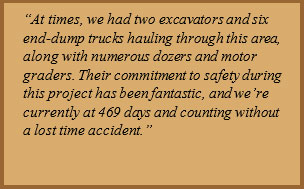
The Center Mine also received a Distinguished Safety Award for 2016 from the LEC. Distinguished Safety Awards are awarded to lignite mines and power plants that have accident rates lower than the national average. BNI achieved a .063 accident rate in 2016.
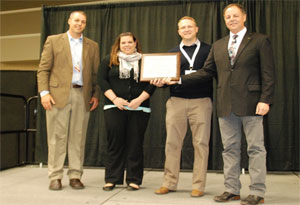
Jay Volk, Stephanie Griffin, and Jon Rudnick accept the Award for Excellence in Surface Coal Mining and Reclamation from Public Service Commissioner
Wednesday, March 22, 2017 1:59 PM
Extreme weather conditions are part of living in North Dakota. It is hot in the summer and cold in the winter. Those temperature extremes are also when electric customers use the most power, which means the power plants need a dependable source of fuel. For the Milton R. Young Station, the supplier for the past 40 years has been BNI Coal’s Center Mine.
 Winter conditions present challenges to the employees of the Center Mine, but it also has its advantages including stable road surfaces that make it easier for haulers to navigate the mine site.
Winter conditions present challenges to the employees of the Center Mine, but it also has its advantages including stable road surfaces that make it easier for haulers to navigate the mine site.At the Center Mine, near Center, North Dakota, the employees know all about changing seasons and the changes in operations to meet the seasonal challenges.
“Cold winter weather means more stress for both employees and equipment,” said Mike Heger, production manager at the Center Mine. “The weather changes, but the things that remain constant at the mine are a focus on safety and our culture to do things right.”
Heger says that winter actually has a couple of advantages to mining coal. One is that employees are generally at work because they take their vacations in the summer when the weather is nice. The second is that the ground is firm, which helps big earth-moving equipment when it’s traveling or moving earth.
The challenges are snow storms and extremely cold weather, such as minus 20 degrees, he said. Blizzards can shut a mine down because of lack of visibility. Also extremely cold weather is hard on equipment because frozen steel can become brittle.
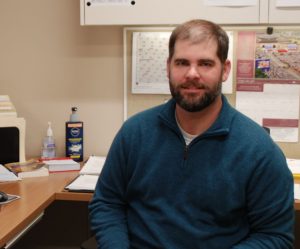 Mike Heger, production manager for BNI Coal’s Center Mine.
Mike Heger, production manager for BNI Coal’s Center Mine.“If it gets below minus 20, we’ll shut the dragline down rather than risk the equipment or the operators,” he added. The dragline is the largest earth-moving equipment at the mine and removes the clay that overlays the beds of coal.
Reclamation activities, such as spreading or collecting top soil or subsoil, stop during the winter. However, miners will use bulldozers to level spoil peaks left from mining activities and grade them to contours that will allow other reclamation activities to resume when spring weather returns.
Despite the challenges, the employees continue digging coal to meet the fuel requirements of the adjacent Young Station, which includes two separate units. During the year, the mine can supply up to 4.5 million tons of lignite coal.
Lignite – a soft coal that is about a third water – provides the energy to turn the water in the power plant’s boiler into a pure stream of steam that is used to turn a turbine and generate electricity. The Young Station provides electricity mostly to rural electric customers in eastern North Dakota and northwestern Minnesota.
BNI employs about 170 workers, with about 70 of them working per shift along with the office and support people. Normally, the dragline works 24-hours per day uncovering coal, but Heger said the mine shuts down for major holidays such as Christmas.
“It’s important that are employees spend Christmas with their families so we adjust schedules to make sure that we have enough coal stockpiled for the power plant to allow our employees time away from the mine,” Heger said.
About one-third of the miners at BNI Coal have worked there more than 30 years while about two-thirds joined in the last 10 years to replace many of the people who started working at the mine in the 1970s when the Young Station was built and the Center Mine began supplying fuel.
“Working in the lignite industry is a profession that people like because of the high wages, the benefits and the safe working conditions,” he added. “As the workforce has changed, we have worked very hard to maintain our focus on culture and safety, and we have been able to find new employees with experience in both mining and using large equipment.”
“Our customer is the Young Station and they expect us to deliver the fuel they need to operate reliably,” Heger said. “Our employees work hard and take great pride in what they do. Whether it’s a cold winter, a muddy spring or a hot summer, we’ve a proven track record of providing fuel that is low cost and delivered right to the power plant.”
BNI Coal is a subsidiary of ALLETE, which is headquartered in Duluth, Minnesota. ALLETE is also the parent company of Minnesota Power.
Article sourced from Lignite Energy Council located here: https://lignite.com/news/north-dakota-winters-present-challenges-to-bni-coals-center-mine/
Friday, July 1, 2016 12:00 AM
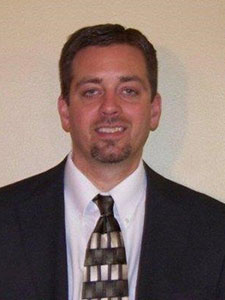
Paul Quist has joined BNI Energy as Manager of Business Development. The Manager of Business Development position was created to better position the company to execute its go-forward strategy. Paul will be leading BNI’s growth initiatives and supporting our energy solutions initiatives including the Allam Cycle initiative. Paul was previously employed with ESCO Supply managing their operations in North Dakota and Minnesota. Prior to joining ESCO, Paul worked with Basin Electric in their business development and CO2 marketing functions. He played a key role in Basin’s acquisition of Montana Lime Stone and Dakota Gasification Company by-product market development. Paul is also an adjunct professor at the University of Mary teaching economics.
Paul and his family live in Bismarck. Paul was elected to the Lignite Energy Council Board of Directors in 2015 and subsequently in 2016. Consequently, Paul is very familiar with the Lignite Industry, has great contacts within the Energy Industry, and work experiences that complement our team nicely. The culture, values and strategic vision of BNI/ALLETE attracted Paul to BNI. I think Paul is a great fit with our team and culture and am excited to have him on our team working closely with us to execute our go-forward strategy.